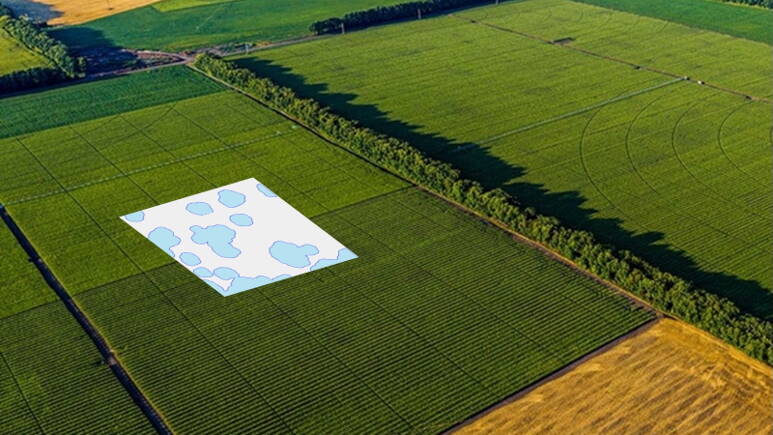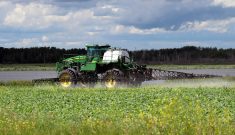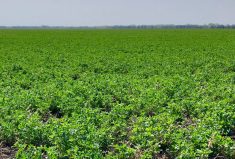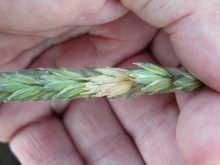Scott Perkin is ready for the 2022 growing season. Like everyone else, the southwest Manitoba farmer still has the rest of the winter to get through, but at least he has key inputs he’ll need for the coming growing season either on the farm or booked with input suppliers.
Perkin, who is part of the family-run Perkin Land and Cattle Company at Elgin, about 70 kilometres southwest of Brandon, says due to anticipated input price increases and possible input shortages, last fall they nailed down the fertilizer and crop protection products they’ll need for their cereal, oilseed, pulse and corn crops.
Read Also

Geco, Gowan team up on predictive weed control using multi-year imagery
A new partnership between Geco and Gowan brings predictive weed mapping to more Prairie farms, using multi-year imagery to forecast patch-prone zones and support targeted herbicide plans.
“We either have everything bought and on farm or at least a commitment from suppliers that products will be available for 2022,” says Perkin, who along with his brother, Darryl, and their families, run the mixed farming operation that includes about 9,500 acres of crops along with a 200-head purebred Simmental cattle enterprise.
“We have all the glyphosate we will need for the year in storage on the farm, and since we also grow InVigor canola, we have a commitment on the supplies of Liberty herbicide we will need too,” says Perkin.
Based on reports from various sources across North America, it is expected there could be shortages of herbicides such as glyphosate, a mainstay herbicide for pre-seeding, in-crop, as well as pre- and post-harvest applications. It has also been speculated that glufosinate supplies, the active ingredient in Liberty herbicide, might also be limited for the coming growing season. And the general disruption and slowdown in the global supply chain could affect availability of a wide range of agricultural products and materials.
Perkin, along with the farm operation, also owns a certified seed retail business and is a consulting agronomist with Perkin Seed and Soil (perkinseedandsoil.com). He says he believes most producers have already acted to line up inputs for the coming growing season, although a few might be caught off guard.

“We’ve heard lots of reports of potential shortages, so it is a legitimate concern,” he says. “However, sometimes the shortages may not be as bad as reports make it sound. With Roundup, for example, farmers also need to remember there are different companies that produce generic glyphosate, so they might have product available.”
Perkin believes most farmers have done some pre-planning to line up inputs, however, there may be “10 per cent or so that haven’t planned ahead.” He says anyone waiting until April or May to get their inputs will either pay a crazy price for those products or have to change their cropping plans based on available seed for those crops that work with the chemicals that are available.
Consider the options
Meanwhile, crop production and protection specialists urge Prairie farmers to be prepared with alternative plans just in case product shortages do materialize. Eric Johnson, a research officer and weed specialist with the University of Saskatchewan’s Department of Plant Sciences, and Tom Wolf, a crop protection specialist and consultant with more than 30 years of experience in the spraying business, say producers should be thinking about their options ahead of the 2022 seeding season.
Johnson says while it was a very dry growing season last year, now with some snow across Western Canada early this winter, there will likely be moisture available to get the crop started this spring. He’s not hoping for dry seeding conditions, but if there is, “based on the past couple of years with really dry conditions at seeding, farmers with early seeding dates could almost get away without applying any pre-seeding burnoff,” he says, noting in some areas there wasn’t enough moisture to even support weed growth. With snow on the ground across most of the West in late January, he says that likely won’t be the case in 2022.
Johnson says with potential shortages of crop protection products, field scouting to identify the weed spectrum out there will be important.

“Perhaps more so than usual, it will be important to identify the weeds you do have,” says Johnson. By knowing what weeds are present, a farmer can determine if they need to apply a tank mix of different products. “There are many products that can be used in a tank mix with glyphosate for broader control, but also many of them can be used as stand-alone products too. By identifying your weed spectrum, perhaps just one product is needed to control specific weeds.” If a producer is seeding early and wild oats haven’t yet emerged, he or she might consider getting away with only applying a broadleaf weed control product.
Johnson also suggests looking at adjusting application rates. “When glyphosate was relatively inexpensive, there may have been a tendency to apply it at the higher rates,” says Johnson. “However, if there is limited supply or if the price is higher, perhaps a lower application rate is sufficient.”
Johnson says growers who have applied glyphosate for many years will remember the 0.5-litre- and one-litre-per-acre rates that were commonly applied and are referred to as the Roundup Equivalent Litre (REL) Rate. There are many different Roundup formulations now with differing concentrations (356, 360, 450, 480, 500 and 540 grams per active ingredient per litre).
If a producer is using the 540-gram-per-litre formulation, for example, they would apply 0.33 and 0.66 litres per acre for RELs of 0.5 and 1.0 litre per acre, respectively, Johnson says. For most annual weeds, a REL of 0.5 litres per acre will be adequate, particularly when tank mixed with other pre-seed burnoff herbicides.
If farmers have been applying the full-litre rate, they may be able to “stretch” chemical supplies by dropping to the half-litre rate. “If a producer is looking to primarily control grassy weeds, such as wild oats and green foxtail for example, Roundup is very effective at this rate,” says Johnson.
Looking at in-crop treatments, Johnson says if producers are growing Roundup Ready crops, there really is no substitute for in-crop weed control if glyphosate is not available. A product like Lontrel (clopyralid) could be used to control broadleaf weeds such as Canada thistle and wild buckwheat, but options are limited. He also says pre-seed products such as Edge granular herbicide (ethalfluralin) might be an option if applied early enough in the spring, although for optimum results it should be applied in the fall.
Finally, if some of the key herbicides are not available, Johnson says pre-seeding tillage might be a last resort option, especially in areas where growing conditions have been or likely will be dry. However, it may be a viable option in wetter areas.
Switch gears

Tom Wolf, with Agrimetrix Research and Training in Saskatoon, says if the herbicide shortages materialize, one option for producers is to switch gears and grow crops that do have herbicides available — for example, grow more cereals and cut back on herbicide-tolerant canola varieties.
Wolf, also known as The Nozzle Guy, covered many of the key points in a blog written in late 2021 called “Dealing with pesticide shortages in 2022”.
As of mid-January, Wolf says increased product prices right now are a good indicator of things to come, but whether herbicide shortages materialize or to what degree probably won’t be confirmed until early spring.
In the meantime, his advice to farmers: “Yes, I’d assume there will be shortages,” says Wolf. “I’d avoid Roundup Ready and LibertyLink crops because those appear to be the hardest hit. I’d emphasize cereals. Those can be seeded early, are competitive, have good disease resistance and have good rotational flexibility.
“I would do everything I could to improve the performance of products I do have and that means using good quality water, water conditioning if necessary, early application and paying attention to the best time of day to apply.
”Wolf says it may mean investing in logistical improvements such as a chemical tendering system that saves time, making those minutes and hours available for spraying.
For more details on management options during herbicide shortages see Wolf’s column at sprayers101.com.
















